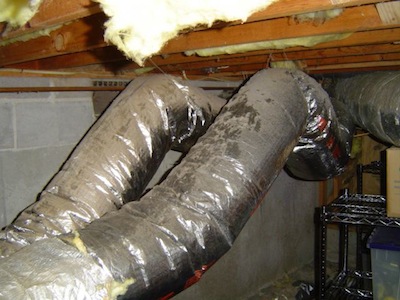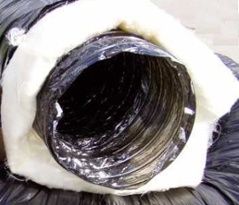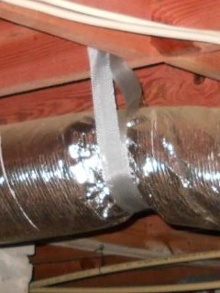Don’t Kill Your Air Flow with This Flex Duct Disease

I like flex duct. Really! In fact, I did an interview yesterday for the Energy Saving in the Home Radio Show and surprised the host, I think, when I said that to him. He’s an HVAC contractor himself and is used to building science types being purists on the use of rigid ducts. (You can catch the show when it airs on Saturday, 10/20/12, or download it from iTunes afterward.) What I don’t like is that flex duct gets horribly abused by a lot of installers. If you’ve been reading this blog for a while, you’ve seen lots of evidence already.
I like flex duct. Really! In fact, I did an interview yesterday for the Energy Saving in the Home Radio Show and surprised the host, I think, when I said that to him. He’s an HVAC contractor himself and is used to building science types being purists on the use of rigid ducts. (You can catch the show when it airs on Saturday, 10/20/12, or download it from iTunes afterward.) What I don’t like is that flex duct gets horribly abused by a lot of installers. If you’ve been reading this blog for a while, you’ve seen lots of evidence already.
As I was looking through old photos the other day, I came across the one above. Do you see what the problem is here? Those deep sags will kill air flow. Flex duct has an inner liner made of plastic  and a wire spiral. When it’s not pulled tight, the inside surface has a very high air resistance. High air resistance means reduced air flow.
and a wire spiral. When it’s not pulled tight, the inside surface has a very high air resistance. High air resistance means reduced air flow.
Another problem is that the sag means that the air doesn’t flow in a straight line, as it should in this case. It goes up. It goes down. It gets tired and poops out quickly. The rooms don’t get as much air as they should.
Yet a third problem here, albeit one that’s a bit hard to see, is that the one support you can see in each of these ducts is a piece of wire. If you’re hanging rigid ducts (hard pipe), wire is suitable. With flex, it’s not. Wire has a greater tendency to constrict the size of the duct at the point of support and create an extra bump that the air has to get past. To support flex duct properly, use straps that are at least 1.5 inches wide. The photo at right shows such a strap.
to constrict the size of the duct at the point of support and create an extra bump that the air has to get past. To support flex duct properly, use straps that are at least 1.5 inches wide. The photo at right shows such a strap.
Here are three things to look for so you can see if your flex ducts look OK:
- Flex duct should pulled tight to reduce inner air resistance.
- It should be supported with straps that are a minimum 1.5″ wide.
- The straps need to be spaced no further than 5 feet apart, but closer is better. Local codes or manufacturers instructions may specify shorter intervals.
Flex duct can work well when it’s sized and installed properly. It’s a versatile product, which is both a blessing and a curse. I wish I could say that it’s usually done right, but the truth is the opposite.
Now go check your flex and see if the opportunity for enhanced comfort and efficiency awaits.
Related Articles
Should Flex Duct Be Banned by Green Building Programs?
Release the Kraken! — The Ductopus Is Bad for Air Conditioning
Keep Your Elbow Rigid — A Lesson in Flex Duct Installation
This Post Has 17 Comments
Comments are closed.

One thing I almost never see
One thing I almost never see is, pictures of this done right. In Texas where I live, it is hard duct which is the oddity. Even with Manual D sizing, the fundamental design I think is “octopus” in these regions. I have *never* seen an example of this design combined with pulling duct tight.
In the absence of doing things to your standards, it appears to me simply more important to size flex duct to carry say 500 feet/min rather than 700. Obviously not optimum for heat gain/loss but at least air flow should be acceptable. Does that make any sense to others?
Allison,
Allison,
From you photo even the 1-1/2″ straps pinches the duct and insulation. An adequate support suggestion would be a basket design which is used for supporting insulated piping. The supports could be HPDE not metal which would minimize cost.
M. Johnson
M. Johnson: It’s certainly rare, but I have seen it done correctly. Yes, you could try to overcompensate to get the correct air flow, but the results would be inconsistent. It’s better just to install flex duct properly.
Blake T.: Yes, I knew someone would point out that the strap compressed the insulation. I don’t think it’s constricting the duct in this case, but as you point out, it’s still not ideal. Do you have any photos of the type of support you’re talking about?
The
The trick to getting these installation right is to use rigid ductwork for all “deviations from straight”, then pull the ductwork taut between the two ends which now point towards each other. The big advantage over a full rigid installation is sound control- the installations are quieter than fully rigid ones.
For those wanting to did a little deeper into some research, ere’s a great follow up paper for more information on this subject: http://www.mmmfg.com/pdfs/060601_CC-KW_DuctTechPaper.pdf
MJohnson:
MJohnson: I agree. Low velocity in ducts isn’t much of an issue, especially when ducts are inside the envelope as they should be. It’s all about air balance and keeping overall static low to conserve blower energy. Also, register throws become much less important when you have a high performance envelope. When ducts are in the attic, conducted heat loss/gain is indeed an issue. But upsizing by one size is a lot better than what typically happens – restricted airflow. Some upsizing is also necessary to avoid those (expletive deleted) bypass ducts on a zoned system.
In high performance homes, target room airflows are often so low that even 500 FPM is unattainable with 4″ duct. This issue causes even the most diligent HVAC contractors heartburn, because for years, they were taught that low velocity is just as bad as excess velocity. That’s simply not the case. I participated in the most recent ACCA Manual D Review Committee mostly to make sure this issue was addressed. Hank agreed, and added the following…
Table A1-1 Air Velocity
* low velocity is not an issue
Appendix 15 (Air Velocity for Ducts and Grilles) goes into depth on this issue, and ends with this gem (thank you Hank!):
A15-5 Conclusion
There are scores of things to worry about when designing and installing a comfort system. Low velocity though a duct airway is not one of them.
Let’s get serious. Flex duct
Let’s get serious. Flex duct is done wrong 99.6% of the time. It would be better to ourlaw it (which no one has the audacity to do). If you cannot get people to do it right, you should get rid of it. It is that simple. Sorry — there are fixes, but they are ignored.
I just re-read my previous
I just re-read my previous comment. Sorry, I was really drilling down on one very specific point someone made that was not relevant to the topic.
I totally agree with JP regarding flex. In the MJD committee, we spent more time than anything else debating how to treat equivalent length data for flex that hasn’t been properly stretched and/or supported. The folks at Texas A&M; who did the research wanted to make sure designers could see what happens with typical flex installation practice. On the other hand, the folks representing the flex industry argued that static losses for flex-done-badly had no place in the standard. Ultimately, the data was included as Appendix 17 “Excess Length and Sag in Flexible Duct.” For those who understand equivalent length and friction loss calculations, that section is a real eye-opener.
Question regarding dense pack
Question regarding dense pack cellulose…I have seen it used in slant ceilings, installed after sheetrock, back-filled. Is there evidence that this is “kosher”, or is there risk of condensation because of air flow within the material?
Flex duct was originally
Flex duct was originally intended to serve as terminal drops for hard duct trunks; IOW, the last six feet or so of duct to a register could be flex to improve sound attenuation and reduce overall installation cost.
Of course, human nature being what it is, I’m certain right after the product came out someone shrugged his shoulders and said “Why not just use it for the whole job?” And so it went…downhill from there.
I have modified all metal duct systems, that were so noisy when the AHU ran that the home occupants had to raise their voices to talk, with sections of flex to dampen the sound and eliminate cross-talk, with no loss of air delivery performance. Of course I combined that effort with adding jump ducts for return air, along with better supply registers. The system to this day works fine. All it takes is some thinking beyond “get ‘r dun”.
Mike M.:
Mike M.: Yes, using flex only for straight runs would be best. Thanks for the link for the interesting paper on pressure drops in flex duct. I’ve just skimmed the paper but will dig into it later.
David B.: It seems that you’ve changed your opinion on flex, so I’d be interested in hearing more about that. In a comment to my article on whether flex duct should be banned, you wrote in April 2011, “If the system gets the right amount of air to the rooms with minimal leakage, then I don’t give a rat’s ass how they accomplished it.” Do you really now think flex should be banned?
John P.: It seems to me that the problem isn’t so much in the product as in the training and motivation of the installers. If you have the same people who are installing flex badly change to installing hard pipe, how much better will it be? I’ve seen bad hard pipe installs, too.
Jerry P.: That’s a good question, but this article is about flex duct, not cellulose insulation in vaulted ceilings.
Cameron T.: I agree. Flex should be used more sparingly than it is, and it’s great at reducing noise.
@Allison: I haven’t changed
@Allison: I haven’t changed my position on flex. You took that statement out of context. Here’s what I said:
“I say the high performance building industry needs to focus on performance rather than products. Test the static pressure, airflow at the coil and room balance. If the system gets the right amount of air to the rooms with minimal leakage, then I don’t give a rat’s ass how they accomplished it. Programs that require Manual D submission are missing the point. Anyone can create a drawing.”
And a follow-up…
“And by the way, getting flex right adds cost. Contractors will discover they may be able to install metal for less than flex, to achieve the airflow targets. Or at least the difference is much less. ”
The fact is, room and system airflow verification is not happening in the vast majority of homes, and poorly installed flex is among the most serious impediments to achieving good performance. So yeah, I agree with John’s point… “If you cannot get people to do it right, you should get rid of it.” But as John said, it’s not gonna happen.
Back to the real world: I routinely specify flex for runouts (thanks for pointing out the noise issue, Cameron). I find that contractors who install metal T&B; or extended plenum duct systems are much more likely to do a good job on the flex runouts.
David B.:
David B.: I thought you were saying that you think flex should be outlawed when you said you “totally agree with JP regarding flex,” so I guess our misunderstanding was on the interpretation of John’s comment. I didn’t intend to ascribe different meaning to your words and don’t think that the part of your comment that I quoted was horribly out of context. The other sentences add some detail, but I think the sentence I quoted cuts to the heart of your argument. Getting the “right amount of air to the rooms with minimal leakage” generally requires testing “static pressure, airflow at the coil and room balance.” It means focusing on “performance rather than products.” It means that it’s going to cost more than just throwing the flex in as quickly as you can.
I appreciate all your contributions here, David, so if you think I quoted you out of context or misinterpreted something, feel free to call me on it. I thought you were in favor of banning flex, and I was wrong about that here. Thanks for the clarification.
No problem, Allison. It’s all
No problem, Allison. It’s all good. The fact that you thought I had changed positions meant that I didn’t express my positions as clearly as I could have.
Here is a GreeSpec listed
Here is a GreeSpec listed product (FlexRight) that solves many of the issues with flex duct installations. Product was invented by a HVAC contractor. http://www.flexright.net/residential.htm
Had a new 16 seer Trane
Had a new 16 seer Trane straight cool air-conditioning unit put in a year ago. Their brand-new design. Had dirty 30 year old duckboards removed and new flex duct installed at same time. About two months later I noticed a smell I’ve been fighting ever since. Live in Florida. Smell is only present when AC is running, Not so bad when in heat mode. Can’t figure this one out. Drain line is clear to outside.
@Chuck, I’m not sure flex has
@Chuck, I’m not sure flex has anything to do with the smell. Maybe a mouse crawled into your ducts and died?
I would have the evaporator coil and surrounds checked for mold. If that’s the case, it may be related to blower or thermostat settings.
Flex duct needs to be
Flex duct needs to be installed closer then 5 feet and with something that is wider then 1 1/2″